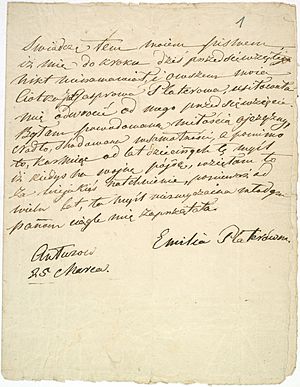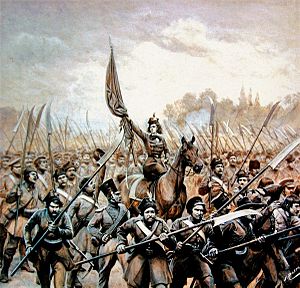Emilia Plater facts for kids
Quick facts for kids
Countess
Emilia Plater |
|
|---|---|
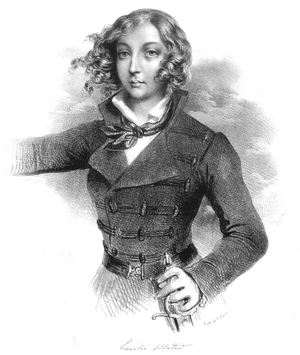
Emilia Plater, anonymous 19th-century engraving
|
|
| Coat of arms | Plater coat of arms |
| Born | 13 November 1806 Vilnius, Russian Empire |
| Died | 23 December 1831 (aged 25) Justinavas Manor, Congress Poland |
| Buried | Kapčiamiestis |
| Noble family | Plater |
| Father | Franciszek Ksawery Plater |
| Mother | Anna von der Mohl (Anna z Mohlów) |
| Military career | |
| Allegiance | Polish–Lithuanian insurgents |
| Years of service | 1831 |
| Rank | Captain |
| Unit | Lithuanian 25th Infantry Regiment |
| Battles/wars | November Uprising |
Countess Emilia Broel-Plater (born November 13, 1806 – died December 23, 1831) was a brave noblewoman and revolutionary. She came from the lands of the old Polish-Lithuanian Commonwealth. This area was divided up by powerful empires. Emilia grew up in a very patriotic family. She believed strongly in freedom for her homeland.
In 1830, she joined the November Uprising. This was a big fight against the Russian Empire. She even put together her own small group of fighters. Emilia took part in several battles in what is now Lithuania. She was given the rank of captain in the Polish forces. When the main army decided to stop fighting, Emilia wanted to keep going. She hoped to join other fighters in Poland. Sadly, she became very ill and passed away.
Emilia Plater became a true hero. Her story spread widely and inspired many artists and writers. She is seen as a national hero in Poland, Lithuania, and Belarus. People often call her the "Lithuanian" or "Polish Joan of Arc". She represents women who fight for their country's freedom.
Contents
Emilia Plater's Life Story
Growing Up: Early Years
Emilia Plater was born in Vilnius. Her family was part of the nobility in the Polish-Lithuanian lands. Her family, the Platers, came from far away in Westphalia. But they had become very Polish over time. Many of them moved to the Grand Duchy of Lithuania.
Emilia's parents divorced when she was nine years old. She was an only child. Distant relatives raised her in their large manor. This manor was called Līksna, near Daugavpils. Her relatives were very wealthy. They owned many lands and had many workers.
Emilia received a good education. She learned about famous heroes like Tadeusz Kościuszko. She also admired writers like Johann Wolfgang von Goethe. She could even read their books in German. Emilia loved Polish history. Her heroes included Princess Wanda and characters from poems. She also looked up to Laskarina Bouboulina, a Greek woman who fought for her country. And of course, Joan of Arc, the French warrior.
Emilia also had unusual hobbies for a girl back then. She loved riding horses and was a good marksman. She was also interested in the local folk culture.
A Spark for Freedom
In 1823, something happened that deeply affected Emilia. One of her cousins was forced to join the Russian army. This was a punishment for celebrating a Polish holiday. This event made Emilia even more determined to fight against Russia.
In 1829, Emilia traveled around the lands of the old Polish-Lithuanian Commonwealth. She visited important cities like Warsaw and Kraków. She even saw the battlefield of Raszyn. A year later, her mother passed away. Her father remarried and did not want to see her.
When the November Uprising began in 1830, Emilia strongly supported it. This uprising was against the Russian Empire. Many women joined the fight, but Emilia became the most famous.
Joining the Uprising
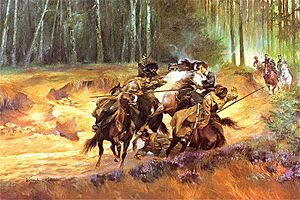
Emilia wrote a note on March 25, 1831. In it, she said that joining the uprising was her own idea. She had always wanted to go to war. She cut her hair short and put on a uniform. Then, she gathered and prepared a group of volunteers.
On March 29, she gave a powerful speech after a church service. The next day, her group attacked a post station. They captured horses for her unit. On April 4, she officially joined the local uprising forces. Some stories say her unit captured the town of Zarasai that same day. However, historians are not completely sure this happened.
Emilia had a plan to take the city of Daugavpils. Her cousins were at a military school there. She hoped they could start an uprising from inside the city. But after checking, she found the city was too well-defended. Her small force could not attack it. So, she gave up that plan.
Her unit had about 280 foot soldiers and 60 cavalry. They also had several hundred peasants armed with war scythes. She then went to Samogitia. On April 30, she joined forces with another unit. On May 4, she fought in the battle of Prastavoniai. Soon after, she fought at Maišiagala.
Leading the Fight
On May 5, General Dezydery Chłapowski arrived with a large army. He took command of all the units fighting in the Grand Duchy. General Chłapowski told Emilia to go home. But she famously replied that she would not take off her uniform. She would fight until her homeland was completely free.
Her bravery was recognized. She was made a commanding officer of the 1st Company. This was part of the Lithuanian 25th Infantry Regiment. She was promoted to the rank of captain. This was the highest rank a woman received at that time.
Emilia spent some time in Kaunas. But the fighters were forced to retreat in late June. On July 8, they tried to capture Šiauliai. But the Russians defeated them. Emilia's unit was protecting the supplies. When the supplies were attacked, many fighters were killed. The Russians captured the supplies.
Final Days
The next day, General Chłapowski decided to cross into Prussia. This meant his army would be held there and stop fighting. Emilia strongly disagreed with this choice. She refused to follow his orders. Instead, she decided to try and reach Warsaw. She wanted to continue the fight there.
However, after leaving the main army, she became very ill. She was with her cousin Cezary Plater and Maria Raszanowicz. The uprising ended in October. Many stories say that her sadness over the defeat made her illness worse. She passed away on December 23, 1831. This happened at the Justinavas Manor. She was buried in the small town of Kapčiamiestis. After the uprising ended, the Russian authorities took away her family's land.
Some historians note that many details of Emilia's actions are hard to confirm. It is not always easy to tell what is fact and what is legend. For example, it's not certain if she truly commanded a unit. Her role as a company commander might have been more of an honor. At Prastavoniai, she fainted from tiredness and fell off her horse. She had to be rescued. At Šiauliai, her friends kept her away from the front lines. They wanted to make sure she stayed safe.
Emilia Plater's Legacy
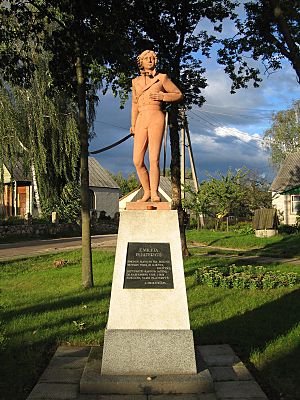
The first poem about Emilia Plater was written in June 1831. Her life and death quickly became famous in the Polish newspapers. The image of a brave woman warrior became very popular. She became a symbol of the uprising.
The famous poet Adam Mickiewicz wrote about her in his 1832 poem, Death of a Colonel. He called her a leader. The poem's description of her death is fictional. It was only loosely based on her real life. The poem even promoted Emilia from captain to colonel. It showed her as the uprising's leader. Mickiewicz also made her seem like a perfect commander. Her soldiers loved her. This poem is still taught in schools in Poland today.
Other books and plays were written about her life. Many were published outside of Poland. Józef Straszewicz published three versions of her biography in French. An English translation was published in New York in 1843. Most later writers followed this idealized version of her life. Emilia Plater was also featured as a role model in a book by Margaret Fuller. This book was about women's rights.

Emilia Plater also became the subject of many paintings. Artists like Hippolyte Bellangé and Wojciech Kossak painted her. One lithograph, based on a painting by Achille Deveria, became very famous. It showed her as a delicate yet noble female warrior.
Emilia Plater was even featured on money. She appeared on a 50 zloty note in 1940. She was also on the 20 zloty note of the Second Polish Republic. During World War II, a Polish women's army unit was named after her. It was called the Emilia Plater 1st Independent Women's Battalion. Its former members later founded a village called Platerówka.

Several streets are named after her. One is in Warsaw. In Kapčiamiestis, where she is buried, a small museum opened in 1984. A monument to Emilia Plater was also built there in 1999.
Emilia Plater is the patron of 14 schools in Poland. She also inspires several schools in Lithuania. Her story continues to be told through art and history exhibitions.
See also
 In Spanish: Emilia Plater para niños
In Spanish: Emilia Plater para niños
- Maria Piotrowiczowa, another female fighter in the 1863 Polish uprising


